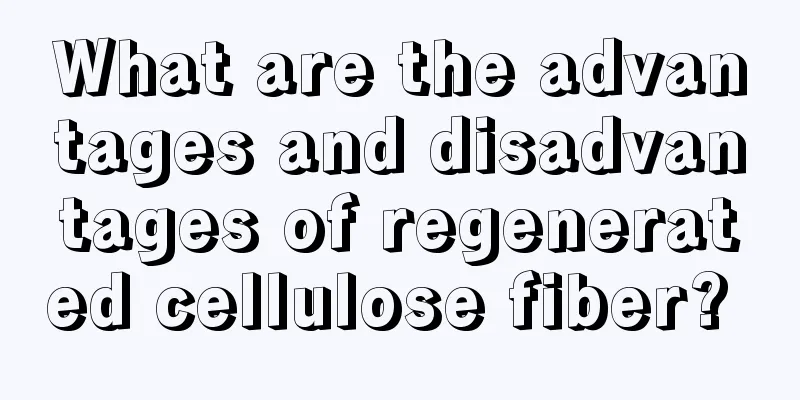What are the advantages and disadvantages of regenerated cellulose fiber?

|
The resources on the earth are not infinite, but human needs are infinite. With the development of society, many people do not understand regenerated cellulose fibers, and believe that such fibers are not good for the human body, especially for "regeneration", and feel that artificial products are harmful to the human body. In fact, Tencel, bamboo fiber, corn fiber and milk fiber are all regenerated cellulose fibers. Regenerated cellulose fiber combines the characteristics of natural fiber and chemical fiber, and is a more environmentally friendly fiber. What are the advantages and disadvantages of regenerated cellulose fiber? Let’s take a look at it next. 1. What is regenerated cellulose fiber and what are its advantages and disadvantages? We all know that the resources on the earth are limited, but human needs are infinite. With the reduction of arable land and the increasing depletion of oil resources, the output of natural fibers and synthetic fibers will be increasingly restricted, and regenerated cellulose fibers came into being. While people pay attention to the environmental performance in the process of textile consumption, they have also re-recognized and explored the value of regenerated cellulose fibers. Today, the application of regenerated cellulose fibers has gained an unprecedented development opportunity. 2. What kind of fabric is regenerated cellulose fiber? 1. Misunderstanding Many people do not understand regenerated cellulose fiber and think that this type of fiber is not good, especially the word "regenerated". In fact, Tencel, modal, bamboo fiber, soybean, corn, and milk fiber are all regenerated cellulose fibers. 2. Features Regenerated cellulose fiber combines the characteristics of natural fiber and chemical fiber and is an environmentally friendly fiber in the new century. They have different properties, but they are all made by spinning cellulose extracted from natural materials. 3. Raw materials Regenerated cellulose fiber is taken from cellulose in natural materials. It has the unique characteristics of natural materials and is an environmentally friendly fiber in the new century. Lyocell fiber and modal fiber are wood pulp fibers; bamboo fiber is bamboo pulp fiber, soybean is the protein separated from soybean meal after oil extraction, polylactic acid fiber is spun after fermentation of corn and other grains, and milk protein fiber is spun from protein in milk. They have different properties, but they are all made by extracting cellulose from natural materials and spinning them. 3. Advantages of regenerated cellulose fiber 1. Natural degradation and environmental protection Nowadays, many materials, especially chemical fibers, cannot be degraded and eventually become white waste. Incineration will also pollute the air. For this type of fiber, you should try to use it as little as possible! Regenerated cellulose fibers are naturally biodegradable. 2. Moisture-absorbent and breathable for good sleep 01. Lyocell: Rich in hydrophilic hydroxyl groups, it has good hygroscopicity. 02. Modal: The fiber has good uniformity, large pores, and good air permeability and moisture absorption. 03. Bamboo fiber: The breathability is 2.5 times higher than that of cotton fiber. 04.Soybean fiber: rich in hydrophilic hydroxyl and amino groups, moisture absorbing and breathable. 05. Corn fiber: has unique wicking effect and moisture absorption and quick drying function. 06. Milk fiber: There are many grooves on the surface, which can easily absorb and store moisture. 4. Smooth, comfortable and close fitting Compared with cotton, regenerated cellulose fiber has good luster and silky smoothness. For example, the cross-sections of lyocell, modal, polylactic acid fiber, milk protein fiber, etc. are round, so they have good luster, and the fabrics made from them feel very comfortable; they will feel particularly comfortable when used close to the body. 5. Healthy, safe and skin-friendly All regenerated cellulose fibers are taken from cellulose in natural materials. Unlike general synthetic fibers, they possess the unique properties of natural materials. For example, soy protein fiber contains 18 to 20 kinds of amino acids, and milk protein fiber is also rich in amino acids, which have good skin-friendly and health-care effects on the body; for example, bamboo fiber has good antibacterial and anti-mite effects. |
<<: How to relieve stomach pain from eating hot pot
>>: What is the white mark on the front of the nail?
Recommend
How long is the survival period for lung cancer liver metastasis and brain metastasis?
When lung cancer metastasizes to the liver or bra...
How to clean oil smoke
Nowadays, every household has installed a range h...
Yogurt and hawthorn can be eaten together
In life, many people like to eat hawthorn, which ...
Basic knowledge about hamartoma
The importance of internal organs to the human bo...
Does thread lifting have any side effects?
Thread lifting is a method of embedding threads a...
What are the symptoms of liver cancer metastasis to the lungs? There are four symptoms
If liver cancer is not effectively controlled, it...
What should I do if my tongue coating turns yellow and my mouth becomes dry
Yellow tongue coating and dry mouth are not uncom...
The hazards of bleach
There are two types of bleach, one is used for bl...
What should be paid attention to in surgical treatment of lung cancer? Introduction to precautions after lung cancer surgery
In severe cases, lung cancer may affect the lives...
Normal range of serum creatinine
For those of us who are not medical personnel, we...
How long can you live after recurrence of esophageal cancer after surgery
Esophageal cancer is a terrible disease. Once you...
How to exercise in the early stages of kidney cancer
How to exercise in the early stage of kidney canc...
How long can you live with advanced small cell lung cancer? It's related to the rate of spread
It is difficult to say how long patients with sma...
How about detoxification capsules
There are many ways to detoxify the body. When wo...
How to treat allergic otitis externa
Autumn has come quietly, the weather has become d...









